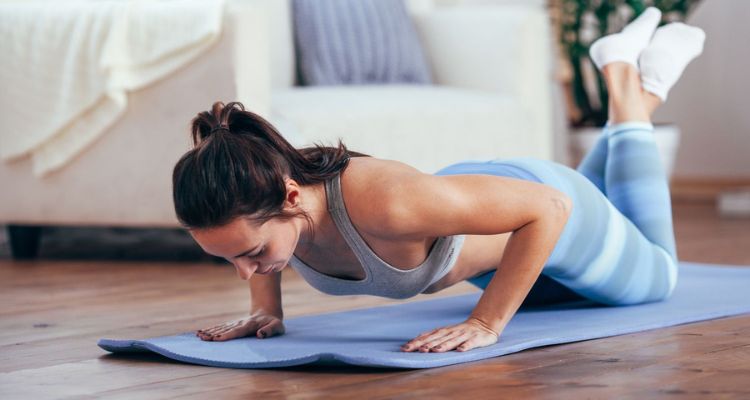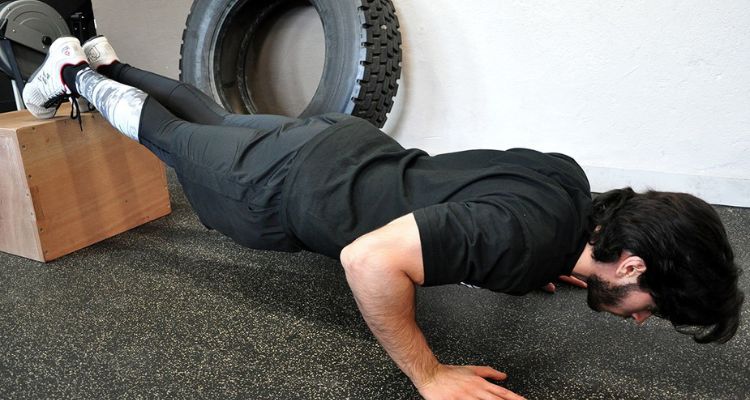Do push-ups or any other workout before going to bed has its benefits?
People do workout before bed because they don’t have much time throughout the day due to their busy schedules. Some people do it later in the day because they enjoy it more.
We have developed this guide to help you find answers about whether or not you should do push-ups or any other workout before going to bed.
Key Takeaways
– Doing moderate exercise like push-ups 1-2 hours before bed can provide benefits without disrupting sleep. Intense exercise directly before bed can negatively impact sleep.
– Benefits of nightly push-ups include building chest, arms and core muscles. They also improve mental strength and self-control.
– Research shows exercise helps align circadian rhythm and improve sleep patterns. But optimal timing and intensity of pre-bed exercise needs more study.
– Beginners can start with 5 sets of 5 push-ups and build up. Athletes can do 5 sets of 10 or more push-ups based on fitness level.
– Try easier push-up variations like wall, knee and incline before standard push-ups to adjust intensity. Go slow and listen to your body.
– Overall evidence suggests push-ups before bed positively impact health. But more research on timing and intensity is needed.
– Try making push-ups part of a consistent bedtime routine. Perceived benefits even if not proven.
– Push-ups work front deltoids, pecs and core. Can increase chest size and upper body strength over time.
– Don’t overlook proper sleep habits like winding down before bed for 1-2 hours. Push-ups compliment healthy sleep routine.
– Talk to a doctor before starting an exercise routine, especially with prior injuries or conditions. Modify as needed.
– Make sure to warm up beforehand and use proper push-up form to avoid injury. Engage core and go down/up in controlled motion.
– Try combining push-ups with other bodyweight exercises like squats, planks, lunges to build full-body strength.
– Stay hydrated and avoid big meals, alcohol or caffeine close to bedtime which can hinder sleep.
– Learn to listen to your body’s signals if push-ups are helping or hindering your ability to unwind and rest at night.
– Keep variety in your workouts and switch between cardio, weights, core strengthening and push-ups to maximize benefits.
– Consider your schedule and energy levels when picking best times to exercise. Consistency more important than strict timing.
– Push-ups alone won’t substitute for a full workout plan or healthy lifestyle. Combine with proper diet, sleep habits, stress management.
Working Out Before Bedtime
Working out after 6 to 7 pm (later in the day) negatively impacts sleep. It’s because, due to the activity, you will trigger your body to be active. And that’s something you don’t want before going to bed.

But a study conducted in 2018 suggested that this perception is only half right. It is a fact that if you perform a heavy activity before going to bed, you will have trouble falling asleep. But there are a couple of factors that you need to consider.
- What about moderate to light exercise – does it also negatively impact sleep?
- What if you perform a vigorous workout for at least an hour or two before bed?
So, what does that mean? It means you can perform light to moderate workouts before bed, including these push-ups. And if you want to do an intense workout, you should do it at least an hour before. In both cases, you won’t have any trouble sleeping.
Benefits of Doing Nightly Push-Ups
Whether these pre-bed push-ups will help you get better sleep or not is debatable. But even if these push-ups don’t improve your sleep quality, there are various other benefits.
Including these nightly push-ups into your bedtime routine is beneficial. It’s because if you have insomnia, doing some push-ups will have a placebo effect.
Besides that, push-ups can help improve joint muscles in your arms and build muscle in your chest, triceps, and shoulders. So with regular push-ups, you can help develop strength and flexibility.
Let’s look into the matter of doing these nighttime push-ups in some more detail.
Improved sleep quality through exercise
Among the primary reasons why people turn towards push-ups before bedtime is that they think it promotes better sleep.
A study in 2013 researched the effects of exercise on various sleep patterns and how these patterns change. Their bodies became more fine-tuned to the circadian rhythm that helps regulate these sleep patterns. So, with regular exercise, you can get your body’s sleep clock consistent as you will be able to develop healthy sleep habits.
Testing the self-control
Regular exercise can provide you with numerous benefits. These benefits are limited to physical, psychological, and physiological attributes.
Have you ever noticed that athletes have better discipline and self-control than others? It is because they spend more time doing exercise and making their meals.
They have better willpower, dedication, and ability to overcome obstacles. This is all because of exercise, the right amount of calorie intake, and proper sleep.
So, when you are do push-ups before bed, you are preparing yourself mentally and physically for success. It is great for your body and mind; a perfect cure for anxiety and depression.
What does research have to say about it?
Overall, the research on how exercise affects your body is still in adolescence. Most people who practice this report less stress and depression after the workout.
Sleep is a process in which your mind and body calm down, relax, and restore after a busy day. Since, exercise helps in reducing stress and depression, it makes sense that you should do push-ups before going to bed.
Another study suggests that vigorous exercise before bed doesn’t impact sleep quality. But it might influence your cardiac autonomic control during the initial sleep hours.
How Many Push-Ups Should I Do Before Going to Sleep?
The ideal way of doing it is to make them a permanent part of your daily routine. You can begin with five sets of ten push-ups. Moreover, you can add a couple of sets of 15 incline push-ups if you like a tougher workout. You can try doing this just two days a week and see how everything goes.
Make sure you listen to your body and adjust your workout intensity accordingly. For the first time, begin with five sets of five push-ups.
And if you are an athlete who does push-ups every day, you can do a couple of sets of 15 push-ups as soon as you get back home.
What Type of Push-Ups is Best to Do Before Hitting the Bed?
Suppose you are a bit out of shape and can’t handle full push-ups. Or you might be struggling to do these push-ups for any other reason. What can you do to make these more beneficial before bed, according to your preferences?
Well, that’s pretty simple.
You can make them easier for your body as they have many variations. Some aim to torture your body, and others are much more humane. Here are some types for your consideration:
Wall push-ups
These push-ups are pretty good for those who are recovering from some injury or for people who are physically very weak. You must place your arms on the wall in a typical push-up style and start performing push-ups as you stand.
By doing this, you are making your arms more used to the push-up mechanism. These push-ups are easier because you are not fighting gravity at all.
Knee push-ups
These push-ups are easier for most people as you can keep your body balanced on your knees. But more importantly, you can make your arms more used to fighting gravity while doing push-ups in this position. It’s an ideal choice for beginners.
However, having your knees on the floor can be painful. You can use a yoga mat to tackle the roughness or hardness of your floor.
Incline push-ups
Okay, these push-ups will allow you to use your bed as exercise equipment. You will have to stand next to your bed and take the pushup position by firmly placing your hands on your bed. Your feet will be on the ground, and start pushing.
These pushups are slightly tougher than the previous two we have mentioned above. Because now, your arms have started to fight gravity in reality.

Decline push-ups
These push-ups involve slowly dropping down and quickly rising with your arms. Now, you are truly getting used to your arms fighting gravity. And when you start doing these push-ups effectively, you can begin full push-ups.
Conclusion:
There might not be enough research available on this topic. But there is enough evidence to support this claim that push-ups or workouts before bed has health benefits and improves overall sleep quality.
Now it is up to you whether you go for a light or intense workout before bed. But it is recommended to go for a light to moderate workout. And if you want a vigorous workout, consider doing it for at least an hour before bed.
But one thing is for sure, doing these push-ups right before bed positively impacts your body. And it can help you deal with your sleep issues in the best possible way.
Push ups before bed FAQs
How to find the ideal workout intensity before bed?
If you want push-ups before bed, consider going for light to moderate workout intensity. But if you want a vigorous workout, consider doing it at least an hour before bed.
Should you work out or do push-ups before bed at all?
There is not much research available on this particular topic. But in some past studies, people who do these workouts before bed have reported that workouts or push-ups can help improve sleep quality.
How do you do push-ups before bed?
Athletes can begin with five sets of 10 push-ups. But if you’re a beginner, you should start with five sets of five push-ups. Based on your current physical state, you can do a couple of sets of ten push-ups. It’s really up to you how many push-ups you should go for.
Do push-ups make the chest bigger?
Yes, push-ups gear towards front deltoids, chest, and core. It’s an excellent exercise for your upper body, increasing your chest size, endurance, and strength.

